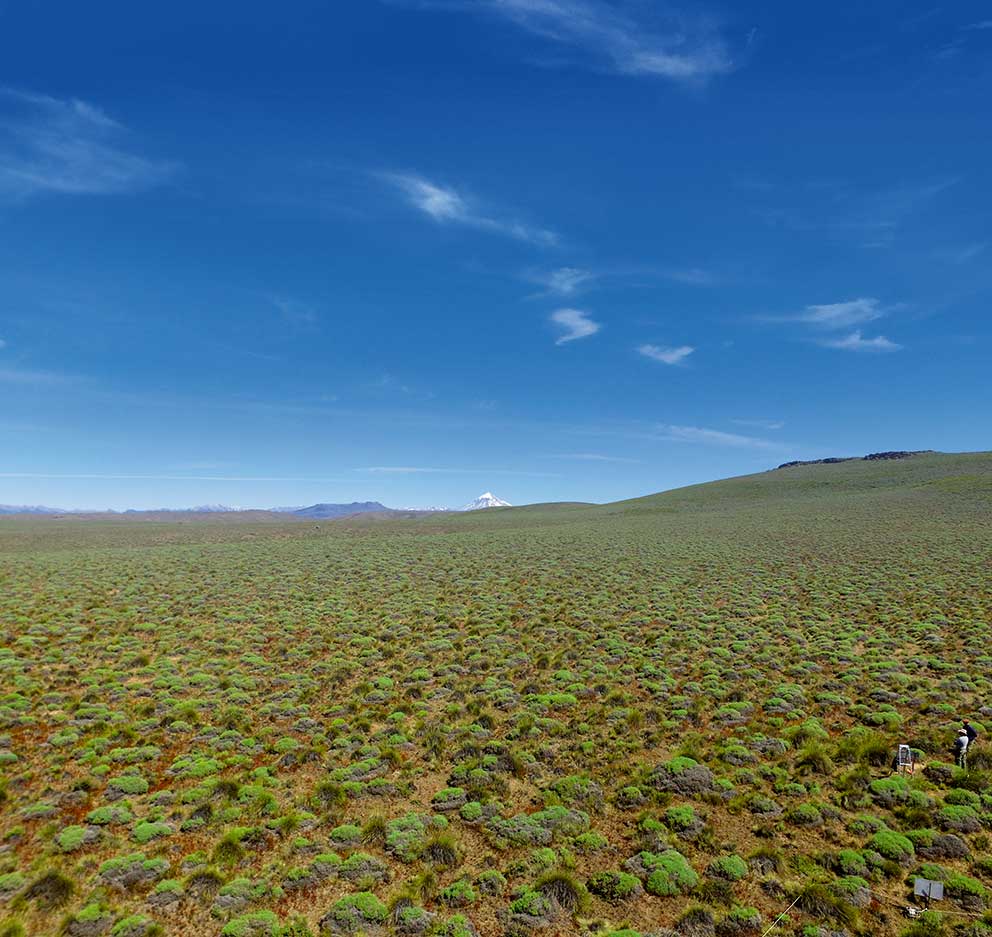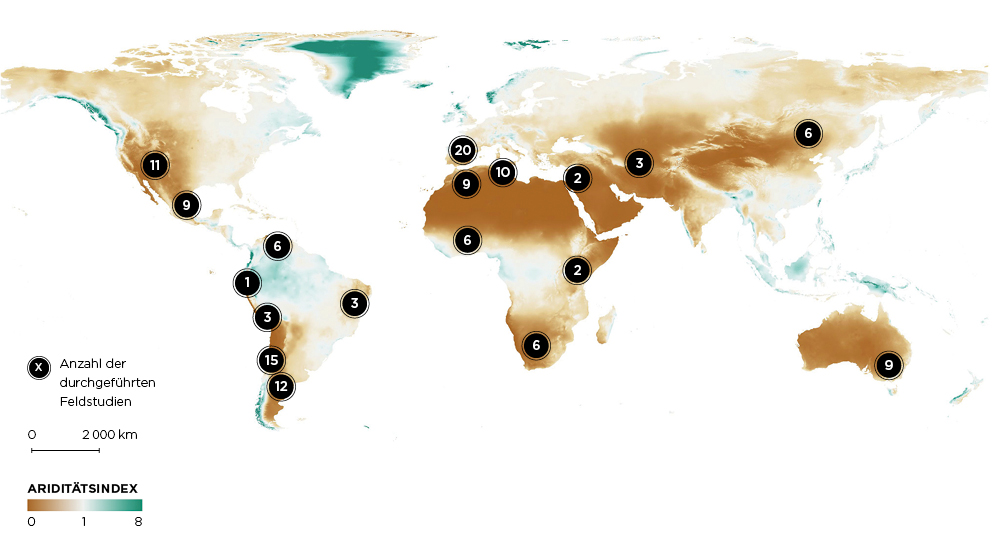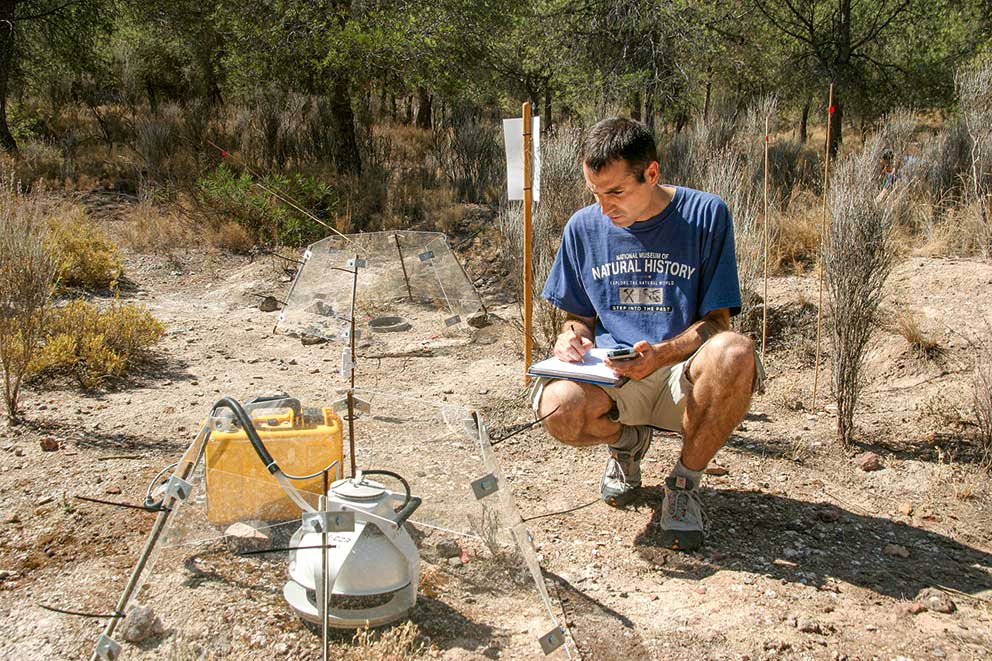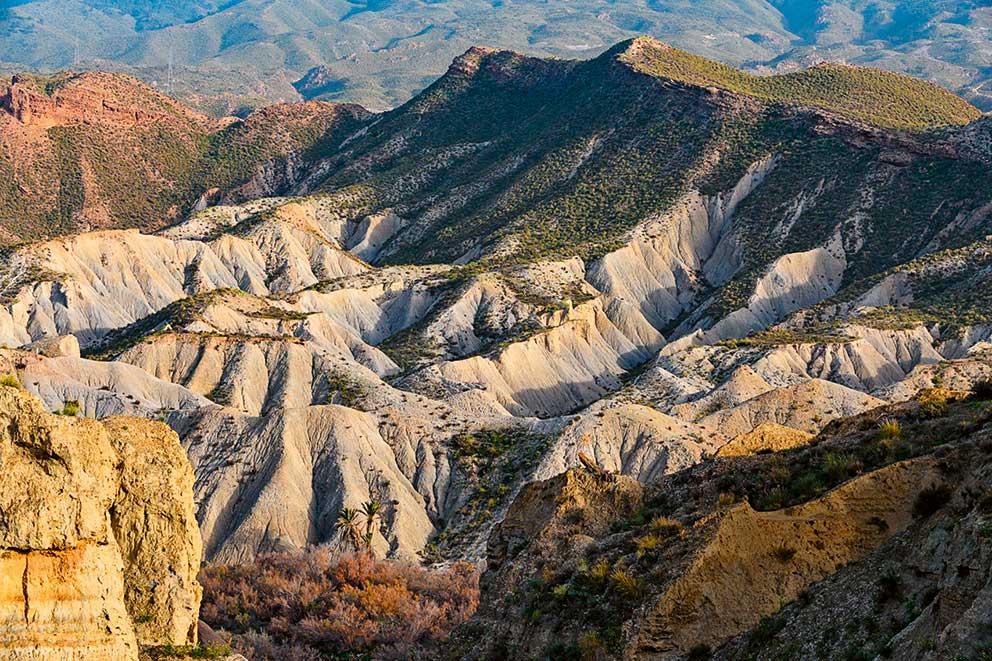Jump to the content
- {{#headlines}}
- {{title}} {{/headlines}}

Professor Dr Fernando T. Maestre is a distinguished researcher at the University of Alicante, Spain, and a professor of ecology at Universidad Rey Juan Carlos in Móstoles, Spain. After his doctorate in biology at the University of Alicante followed by a postdoc at Duke University, United States, he was awarded a Starting Grant by the European Research Council (ERC) in 2009 for carrying out the global BIOCOM research project. Maestre has spent time working on research in countries such as Australia, Germany, China, the UK and the United States and was granted a Humboldt Research Award in 2014. Since then, he has been cooperating closely with German colleagues in Berlin, Cologne and Leipzig to analyse samples and data collected in arid zones. Also in 2014, the ERC awarded him a Consolidator Grant for the follow-up project BIODESERT. This gave Maestre and his international team of collaborators the possibility to further investigate how global dryland ecosystems are responding to climate change and desertification and to propose measures to mitigate their impacts.

Kosmos: Mr Maestre, when we talk about climate protection, many people immediately think of the rainforests and reforestation projects. But you explore what arid zones can do for climate protection.
Maestre: That’s true. Traditionally, not much attention has been paid to dryland zones, although they account for more than 40 percent of the earth’s surface. But they don’t produce much biomass compared to other biomes, as there simply isn’t enough water to sustain a continuous vegetation cover. Added to which, scientific heavyweights like Germany and the United Kingdom don’t have any dryland regions of their own. The United States do have drylands but most studies on climate protection carried out there have been done in ecosystems with more vegetation.
Kosmos: How did you manage nonetheless to establish a research network that is now active on five continents and funded by the European Research Council (ERC)?
Maestre: I had the idea of studying drylands on the global scale when I was still a young PhD student. When I returned to Spain after a postdoc stint in the United States in 2005, the amount of funding I had at the time was so tiny that I could only pursue this idea in Spain. But I already knew that I wanted to make it much bigger.

The Biocom Project
The black dots on the world map at the top indicate the location and number of experimental sites in the EU-financed BIOCOM project. Headed by Fernando Tomas Maestre and involving colleagues working in 19 countries on five continents, the project is the first to explore the composition of plant and microbial communities and the functioning of ecosystems in the world’s arid zones in a systematic way. In drylands such as the Pampa, near the Lanín volcano in Argentina (photo left), mean annual evaporation exceeds mean annual precipitation. Arid zones account for 41 percent of the Earth’s surface and are home to more than a third of the world’s population. They are of great climate relevance because their soils and vegetation can store crucial amounts of carbon dioxide. One of the findings of the BIOCOM project was that biodiversity in arid zones is a decisive driver of their capacity to provide ecosystem services essential for human life as well as for tackling global warming.

Kosmos: What happened?
Maestre: The breakthrough came a year later when my team and I got funding from the Ibero-American Program of Science and Technology for Development, an alliance of Spain, Portugal and Latin American countries. This meant we could build up a network that brought together a diverse assemblage of experienced and emerging research groups. So suddenly we had partners in Argentina, Chile, Venezuela, Brazil, Nicaragua, Peru, Ecuador and Mexico.
Kosmos: What was cooperation like in such a diverse group?
Maestre: I asked all the research teams to do everything exactly as we had already done it in Spain. Our approach in Spain had proved its worth, now we had to test if it could function in a different environment. And it did!
“Until a few years ago, nobody knew that the soil in dry regions stores so much carbon.”
Kosmos: So well that it convinced the ERC?
Maestre: My first application in 2007 was rejected. A year later, I applied again and this time it worked. Suddenly my lab and I had enough funding to recruit the necessary staff, analyse the vast quantities of soil samples obtained and pay for the shipping. We were now able to recruit additional partners from all over the world to join our network. During my stay in Germany as a Humboldt Research Award Winner, multiple German colleagues joined the crew, either by conducting fieldwork themselves in countries like Ghana or Burkina Faso or by analysing soil samples for variables not measured in my lab.
Kosmos: What were the results of this collaboration?
Maestre: We managed to prove that plant and microbial diversity plays a key role in maintaining the capacity of drylands to provide essential ecosystem services linked to soil fertility and the production of plant biomass, which are fundamental for supporting the livelihood of more than 1 billion people globally. Until a few years ago, nobody imagined that biodiversity could play such an important role in global drylands. Also, in the last 30 or 40 years, we have seen a real greening of drylands worldwide. This indicates that a lot of additional carbon bonding is taking place.
Kosmos: What has caused the greening?
Maestre: The increase in the proportion of carbon in the atmosphere has made plants more efficient in taking up water and thus stimulated their photosynthetic capacity. So, they have been able to grow more. However, in some regions this effect has already reached its peak, especially as climate change is responsible for increased warming and decreasing levels of rainfall.

Kosmos: But will the additional growth not be able to compensate for the lack of rain caused by climate change?
Maestre: We can’t make any generally valid statements about future rainfall levels across the world yet. Some areas may receive more rainfall, but others will experience extended droughts and receive less rainfall. But we are confident that global warming is increasing evaporation and associated water losses, and this effect may not be compensated for by the positive effects on plant growth promoted by having more CO2 in the atmosphere. This is aggravated by the fact that the dry areas in some regions of the world are in a bad state.
Kosmos: Why is that?
Maestre: One reason is that the trees and shrubs have been cut down in many dryland areas, which often have also been overgrazed. Drylands host more than 2 billion people, 90 percent of whom live in developing countries where they rely on what the environment has to offer – from their livestock who graze on existing vegetation to whatever they can cultivate.
Kosmos: What would have to change?
Maestre: We could do a lot by managing grazing. We are getting very revealing data on how livestock grazing affects dryland ecosystems and how much grazing a dryland ecosystem can support before it becomes irreversibly degraded. Measures to help to conserve biodiversity are also key, as our data demonstrate the importance of plant and soil biodiversity in improving plant productivity, preventing soil erosion and delaying the onset of desertification.
Kosmos: When people are struggling to survive, environmental protection is not a priority. How are your suggestions received?
Maestre: In developing countries, we often have a harder job explaining to people that they must change certain behaviours, not just for environmental reasons but because otherwise they are endangering their own livelihoods.

Kosmos: What kind of contribution are African researchers making here?
Maestre: They carry out a large share of the field studies on this continent. In our network we have researchers from Niger, South Africa, Namibia, Botswana, Algeria, Ghana, Morocco, Tunisia and Kenya. We make sure that they know the methods and how to use them. It is certainly time-consuming, but I personally find it very enriching.
Kosmos: You were at the heart of this project from the very beginning and determined the methods. But a network is composed of many researchers with their own ideas. Hasn’t anyone ever banged their fists on the table and said, “my idea is better”?
Maestre: No, never. But other people’s ideas have enabled us to hit on approaches that we hadn’t come up with ourselves. This has made us able to answer questions I wouldn’t have thought of in my wildest dreams.
Kosmos: Can I tempt you into a prediction: will the arid areas be greener 20 years from now?
Maestre: If we want to achieve that, we would have to immediately start on an ambitious conservation and rescue programme. We work hard to publicise the results of our research; we do radio and television interviews and use social media to disseminate our findings, but the politicians haven’t yet shown much interest in our results or asked for advice.
Kosmos: Not even in your own country, Spain, which is one of the EU countries most threatened by drought?
Maestre: Unfortunately, not. But if we don’t do anything now, in the future, southern Spain will have a landscape rather like northern Africa and we will likely exhaust the aquifers. I really wish that Spain and other affected countries would finally wake up and declare the protection of drylands and the sustainable management of their water resources a national priority.
published in Humboldt Kosmos 111/2020
